
Rhododendron & Azalea News
John Doppel, 1930-2020
edited by Steve Henning
Valley Forge Chapter ARS
Part 1: Reminiscences on My Rhododendron Road
|
Part 1: Reminiscences on My Rhododendron Road
by John Doppel

“It was my father, a forester, who managed to instill an interest in plants in me at an early age. We lived just outside Washington, D.C. in the late 1930's. There was an extensive woods nearby and sometimes on weekends we would go out to collect and identify different plant species. Over time I was able to identify quite a few things. I became an expert at spotting poison ivy, a plant that caused me a lot of misery.”
Visit to Joe Gable in Stewartstown, PA
“In the 1940's we moved to a farm about 25 miles north of Philadelphia and I continued to do some plant collecting; often propagating from seed and cuttings. Over time I began to focus on rhododendrons, a diverse group with pretty flowers. In my late teens my father and I made an excursion to Joseph Gable's farm in Stewartstown, PA. Mr. Gable, a very unpretentious and gracious person, allowed us to wander through his woods full of all sorts of rhododendrons that I didn't even know existed. I learned later that the source of many of them was from contacts he made in Great Britain. His interest had been stirred when he saw the beautiful gardens there as he passed through the country as a soldier during WW1. Mr. Gable suggested that if I had an interest in hybridizing, I better get started early because it takes a long time to see the results of your labor. Good advice but I put a higher priority on other pursuits in my life and did rhododendrons on a low level. My observation was that working with rhododendrons and azaleas the way he did was not a road to riches, but I'm sure he got a lot of enjoyment and satisfaction from what he was doing and made a lot of friends along the way.” [Joe Gable received the ARS Gold Medal in 1953]
9 Months of Winter and 3 Months of Bad Weather
“In 1964 I moved my family to Oakland, Garrett County, MD, located on the Appalachian plateau. At 2,500 ft, its winters were long and cold (down to -25°F [-32°C]), with an average snowfall of 100 inches. Summers were short but usually pleasant. Natives said they had 9 months of winter and 3 months of bad weather.”
Visit to Yates, Fetterhoff, and Delp in western PA
“About 40 miles from Oakland was the aptly named town of Frostburg, MD, that had the same climate. That was where Maletta Yates and her husband Henry lived. They had collaborated extensively on rhododendron hybridizing with Joe Gable. Some of the Yates hybrids that you might find today are: Ida Bradour, Treena, Ravels, Yates Best and Second Best, Natasha, Andrea, and the evergreen azalea Frostburg. I very much enjoyed visiting their place as Maletta guided me around pointing out the different plants and their backgrounds. She showed me how to make a cross by plucking a couple of stamens, shooting the pollen loose, placing it on the stigma of another flower and then covering it with a small, rolled up piece of aluminum foil to protect it.”
“Since Maletta didn't drive, I arranged that my wife and I would take her on a trip to visit Bill Fetterhoff who lived at Gibsonia, PA, just north of Pittsburg and to Weldon Delp in Harrisville, PA. She had never been to Weldon's place, whereas he had been to her garden several times and was using several of her plants in his hybridizing program.”
“Bill Fetterhoff's place was filled with plants to the extent that there was no lawn, just paths. There were many nice lepidotes and elepidotes. I still have one of his lepidotes -Jill- a light yellow. He had found a nice R. maximum plant that had cream colored flowers that would be useful in breeding for a hardy yellow. It still shows up in the pedigree of some of the seedlings that I am growing at the present time. Bill loved to discuss the virtues of different varieties he used in his crosses, but my novice ignorance prevented me from contending with him.”
“We went from Fetterhoff's to Delp's and arrived there at dinner time without advance notice. When I knocked on his door, the reception that I got was less than enthusiastic but when I said that I had Maletta Yates with us, his attitude improved dramatically. After his meal he gave us a very good tour. In addition to conventional hybridizing, he was experimenting with temperatures approaching 120ºF [49ºC] and high humidity to make crosses of incompatible varieties — lepidotes with elepidotes or kalmia, and even maddenii. From what I could see the results were not encouraging. He was also experimenting with tissue culture and the use of flower tissue to change the number of chromosomes in a plant. We observed that everything that he was working with was either in a greenhouse, an unheated plastic house, or a lath house, which would explain the variability of the hardiness of his plants. Maletta was very surprised that he did not field test his plants.” [Weldon Delp received the ARS Gold Award in 1986]
Visit to Lannie Pride in Butler, PA
“On another trip we visited Orlando Pride's nursery in Butler, PA, shortly after he passed away. His handling of seedlings differed considerably from Delp's. We saw some small ones set out in ordinary soil without mulch and without protection from the sun, wind or cold. I decided that when I got around to it I would more or less follow his lead. I now put my seedlings in the ground in an open field when they are very small — usually the first summer, but I mulch them and cover them with grow cloth the first winter.” [Orlando Pride received the ARS Gold Medal in 1979]
Visit to Tony Shammarello in Ohio
“Back in 1978, my family and I took a cross country trip stopping at Tony Shammarello's when we were passing through Ohio. He was not only a nurseryman but also a talented landscaper and had created a beautiful garden scene. There was a small quarry wall as a back drop and around the beds were meandering paths carpeted with ajuga instead if grass. When I asked him about yellow rhododendrons his response was that he did not favor yellow in the landscape but rather pink or white. He said that he would let David Leach pursue the yellows. I did, however, did notice a bright yellow deciduous azalea in bloom in one of the beds.” [Anthony Shammarello received the Gold Medal in 1973]
Visit to Dr. William Tolstead in Elkins, WV
“Another old timer that I got to visit several times was Dr. William Tolstead who was a botany professor at Davis and Elkins College at Elkins, W.VA. Getting there was half the fun, twisting along the mountain roads where the truckers claimed they wore out their brakes as they kept confronting their own tail lights. Elkins is located in a large bowl at relatively high altitude in which cold air settles in winter. After one extremely cold winter the only things that I saw blooming were a large old ‘Merley Cream’ and some R. minus, var. carolinianum. Doc Tolstead was kind enough to give me a tour around the place on his old Ford tractor as I rode on a fender while he pointed things out and answered my questions. He took a container of fertilizer along and threw hands full on the plants as we passed them to “give them a boost. ” Along the way he asked me how old I was (then in my 50's) which to him was par for the course for people to get into hybridizing. I inferred that he had the same view as Joe Gable, that to accomplish much in the field, you had to start at a younger age. He was working with lepidotes, elepidotes and azaleas and had come up with some very attractive plants. I crossed his ‘Tolstead's Ma Belle’ with ‘Virginia Delp’ and came up with ‘Ruth's Showstopper’ and ‘Ruth's Sister’.” [Dr. Tolstead registered over 50 rhododendron hybrids, many hardy to -30°F (-34°C)]
Moving to Lenhartsville, PA
“In 1990 I sold my business and retired. In the spring of 1991, we moved to a home with ten acres in central eastern Pennsylvania where I could pursue my plant interests. We are on a hill where the wind blows free and the sun shines brightly. The soil is slightly acidic, stony shale that supports the growth of rhododendrons. Since we have been here the temperature has dipped as low as -15°F [-26°C] along with fierce winds that lasted for several days. All the growth on the rhododendrons above the snow line was devastated. Temperature alone is not the absolute measure of a plant's hardiness. That winter ruined ‘Firestorm’ (-25°F [-32°C]) while ‘Ring of Fire,’ in a little plastic tent, was unharmed and bloomed the next spring. Summers here usually have strong dry winds and days running over 90 degrees. I try to come up with plants that have eye-catching flowers good leaves, decent plant habit and the ability to grow here.
I've become obsessive-compulsive about making crosses and raising seedlings but I'm not ready for counseling yet.”
Views of the Doppel's Lenhartsville Home & Gardens

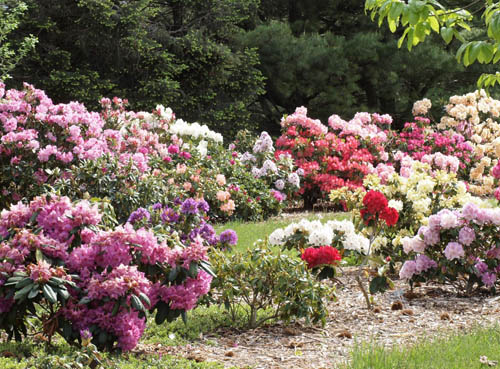
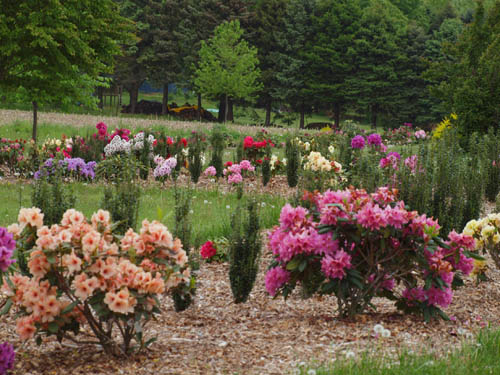
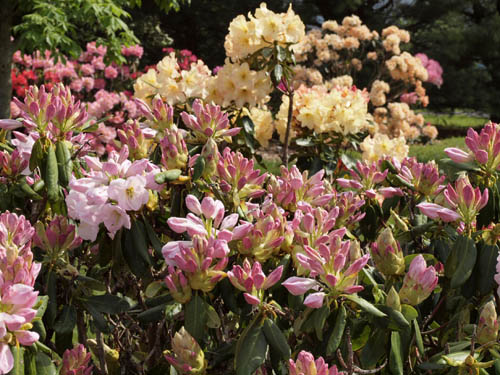
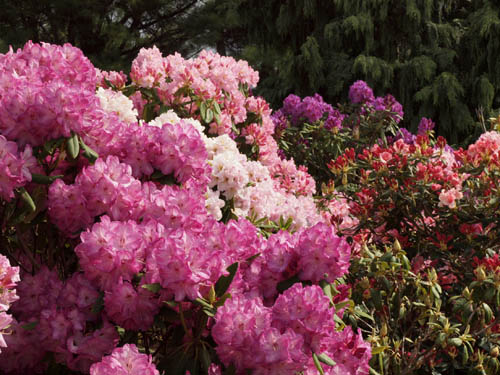
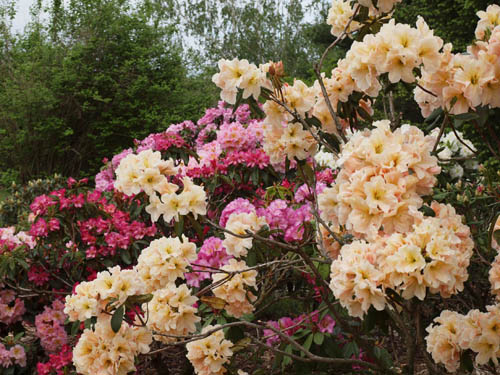
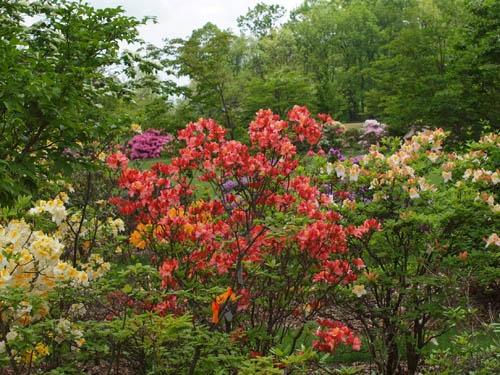
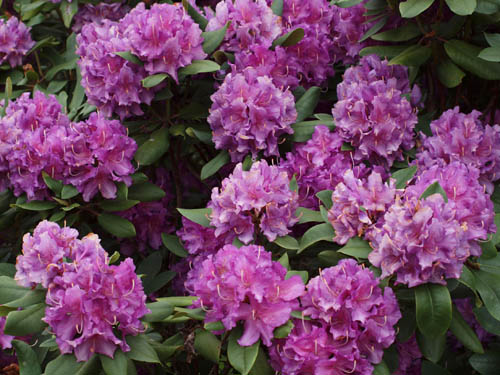
“Here are my very unscientific impressions of a few species:
* R. maximum is hardy but doesn't convey that characteristic to its offspring as constantly as catawbiense. Its flowers are small and it blooms later in the year when the sun is hot. The leaves yellow in the sun. It conveys yellow to its offspring and flowers better than catawbiense.
* R. catawbiense stands cold well, but heat not so well.
* ‘Yak’ doesn't stand hot sun. R. dicroanthum seems to stand sun.
* R. ponticum foliage can get badly desiccated in some winters. One winter when it never went below 0ºF (-18ºC), ‘Purple Passion’ foliage was all brown and ‘Peter Alan’ just dropped all its leaves.
* R. fortunei on the other hand seems very resistant to winter desiccation but it can't stand summer sun.
* R. brachycarpum holds up well in both cold and heat but its flowers are small.
* Tigerstedt hybrids stand heat and cold.
* Tetraploids are not hardy. The buds on Supernova did not bloom after a winter that never reached -5°F (-21°C).
* I think R. proteoides and R. pronum can stand some cold but summer heat kills them quickly”.
Part 2: The Man, Husband, Father, Grandfather and Friend
by Tom Ahern
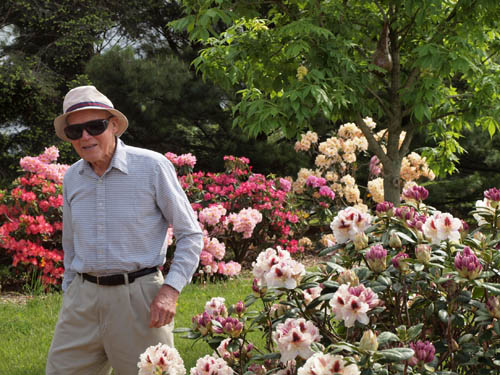 Born on September 5, 1930, John Doppel developed an interest in plants at an early age. He and his father would spend many hours in the woods learning about and collecting native plants. He excelled in high school and college both scholastically and in sports. He graduated from Penn State's Mont Alto in 1952 with a degree in Wood Utilization which he put into use when he started his hardwood molding business.
Born on September 5, 1930, John Doppel developed an interest in plants at an early age. He and his father would spend many hours in the woods learning about and collecting native plants. He excelled in high school and college both scholastically and in sports. He graduated from Penn State's Mont Alto in 1952 with a degree in Wood Utilization which he put into use when he started his hardwood molding business.
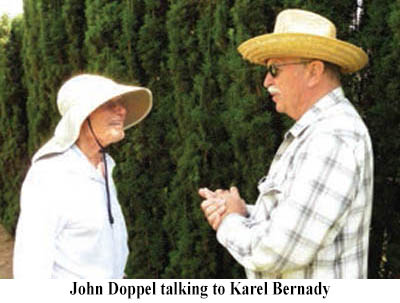 He developed an interest in rhododendrons early on but because of family and business responsibilities, he was not able to accomplish any significant results. In 1991 he sold his business and retired. He moved his family to a 10 acre property in Mideastern Pennsylvania. Now he had the time and space to pursue his dream of creating unique rhododendrons. His interest was mainly in yellow flowers and flowers with blotches.
He developed an interest in rhododendrons early on but because of family and business responsibilities, he was not able to accomplish any significant results. In 1991 he sold his business and retired. He moved his family to a 10 acre property in Mideastern Pennsylvania. Now he had the time and space to pursue his dream of creating unique rhododendrons. His interest was mainly in yellow flowers and flowers with blotches.
He jumped into hybridizing with both feet, creating thousands of seedlings, planting them in the ground their first spring, using any mulch that he could get his hands on, from his neighbors leaves to fine sawdust from a local wooden spoon plant. They were subjected to summer sun and desiccating winter winds. His favorite saying was “I don't raise no sissies”.
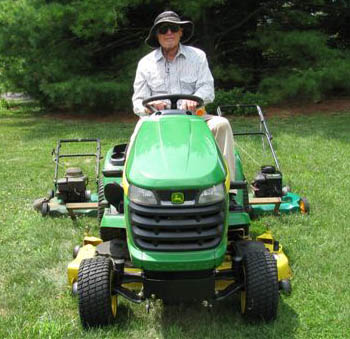 John and Holly were always ready to host chapter picnics and garden tours. At one September picnic, we drove into their driveway and John had it lined with over 100 plants, all dug and balled with plastic shopping bags. These were really nice plants that he culled from his seedlings and removed them so he would have more room for new seedlings and gave them to chapter members. Many of John's giveaways now adorn members gardens and are worthy of recognition.
John and Holly were always ready to host chapter picnics and garden tours. At one September picnic, we drove into their driveway and John had it lined with over 100 plants, all dug and balled with plastic shopping bags. These were really nice plants that he culled from his seedlings and removed them so he would have more room for new seedlings and gave them to chapter members. Many of John's giveaways now adorn members gardens and are worthy of recognition.
Most of the trees and shrubs that John grew in his garden were grown from cuttings that he took from the woods or other gardens. One of his favorites was a weeping peach tree that he found somewhere.
John was very inventive and always found an inexpensive alternative to solving his challenges. One interesting one was his lawn mower. Since he had a lot of grass to mow, he bolted two yard sale push mowers to the back of his tractor so that he could mow a wider swath. He would start each mower then hop onto the tractor and away he went. John had three children and six grandchildren and named one of his 38 registered plants after each of them.
John was always soft spoken, mild and generous. He was a talented plantsman and woodworker. In fact, he excelled at everything that he put his mind to. He was ill for the past few years and wasn't able to participate in many chapter activities. He finally succumbed to the COVID virus on December 18, 2020. Though we will miss John, his memory will live on and we will enjoy his plants in our gardens for many years to come.
The following is from the Spring 2008 Journal of the American Rhododendron Society
John Doppel of Lenhartsville, Pennsylvania, invited his dentist, Dr. Alan Robertson, to photograph his garden during the 2007 bloom season. Dr. Robertson does photography as a hobby and used the photographs he took in the garden to make the poster below to hang in his dental office. Mr. Doppel raised all the plants in the poster from seed except for three red ones and one deciduous azalea.

Photos by Dr. Alan Robertson
Part 3: Hybridizer Extraordinaire
Fortuanely John was able to name and register his best hybrids. Here are most of them:
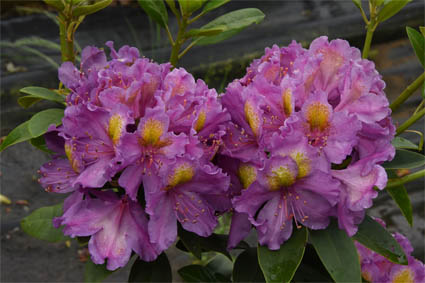 Angelina Dee Elepidote, ‘Edith Bosley’ (s) X ‘Edwin O. Weber’, reg. 2011, hardy to -10°F (-23°C), named for John's granddaughter. |
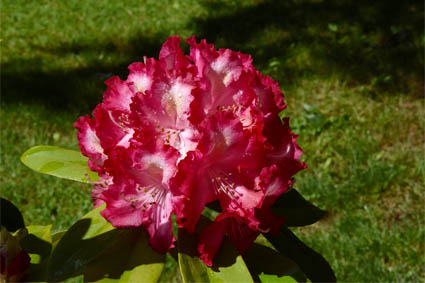 Austin's Firecracker Elepidote, ‘Red River’ (s) X ‘John Paul II’, reg. 2011, hardy to -10°F (-23°C), named for John's grandson. |
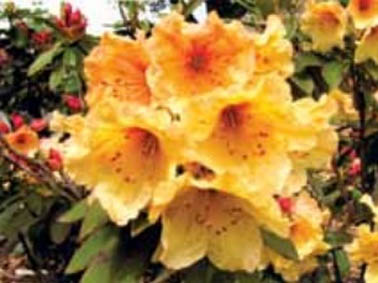 Austin's Gold Elepidote, ‘Jawndice’ (s) X ‘Early Light’, reg. 2011, hardy to -10°F (-23°C), named for John's grandson. |
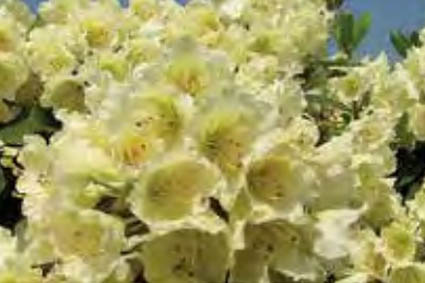 Banana Cream Elepidote, ‘Bisque’ (s) X ‘Capistrano’, reg. 2015, hardy to -10°F (-23°C). |
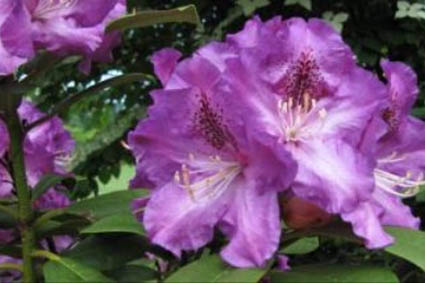 Bethany Jade Elep., ‘Arthur Bedford’ (s) X ‘Jonathan Shaw’, reg. 2005, hardy to -10°F (-23°C), seed & pollen fertile, T. Ahern seed. |
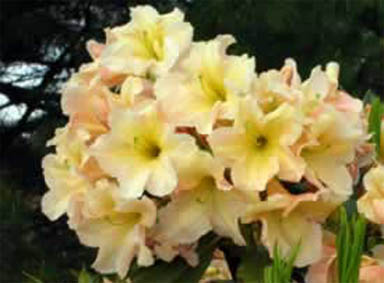 Bisque Elepidote, ‘Rio’ (s) X ‘Tan’, reg. 2005, reported to be pollen sterile but seed fertile, seed from T. Ahern. |
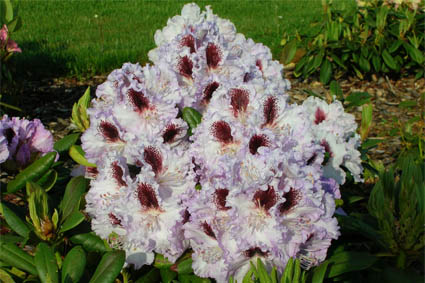 Calafrilly Elepidote, ‘Calsap’ (s) X ‘Cape White’, not registered, frilly white flowers with dark purple blotch. |
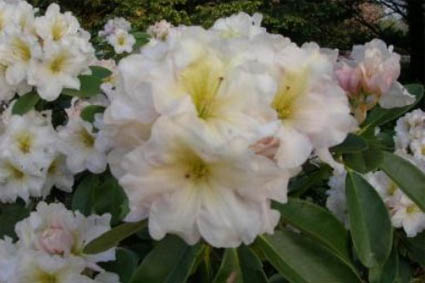 Carl Peter Elepidote, ‘September Song’ (s) X ‘White Dimples’, reg. 2011, named for John's son, seed from T. Ahern. |
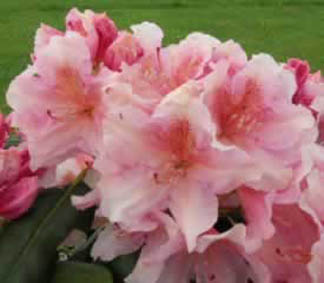 Christina Dee Elepidote, ‘Casanova’ (s) X ‘Wyandanch Pink’, reg. 2005, tolerates winter sun & wind well. |
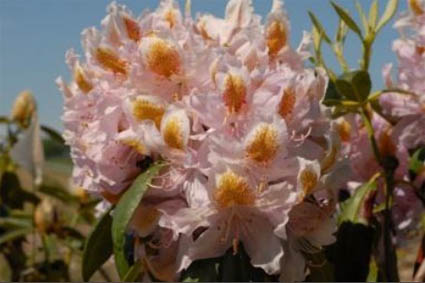 Curves Elepidote, [(‘Madame Jules Porgès’ (s) X ‘White Peter’)#3], not registered, white with greenish brown blotch. |
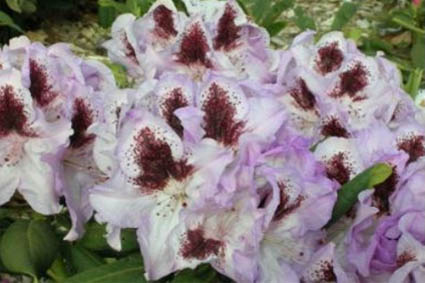 Dalmatian Elepidote, ‘Madame Jules Porgès’ (s) X ‘White Peter’, reg. 2013, the blotches led to the name Dalmatian. |
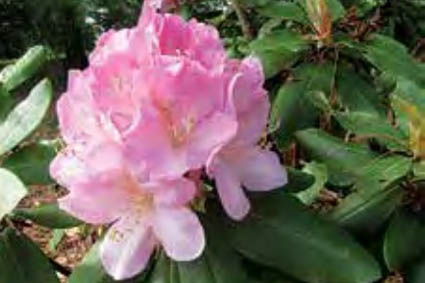 Dawn Debonair Elepidote, ‘Winning One’, open pollinated, reg. 2015, hardy to -10°F (-23°C). John collected the seed in 1994. |
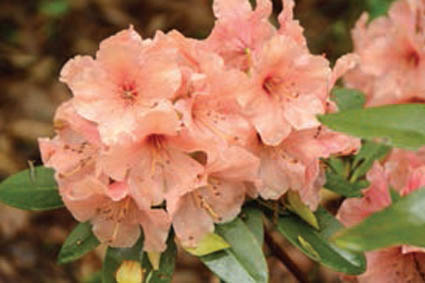 Dawn Star Elepidote, ‘Capistrano’ (s) X ‘Skipper’, reg. 2013, It was hybridized & registered by John but named by D. MacMullin. |
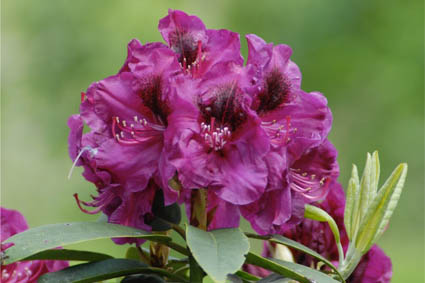 Diane’s Delight Elepidote, ‘Peter Alan’ (s) X ‘Anah Kruschke’, reg. 2005, Both pollen and seed fertile. |
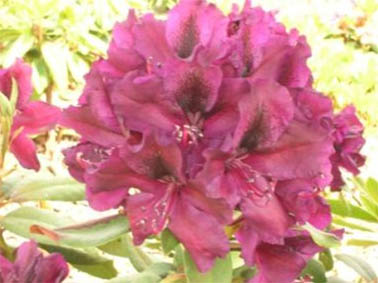 Fay Dee Elepidote, ‘Diane’s Delight’ (s) X ‘Cape White’, reg. 2011, John named for daughter-in-law. |
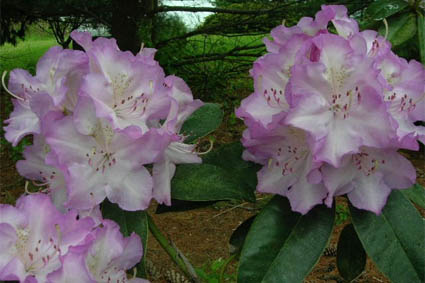 Holly’s Choice Elepidote, ‘Blue Peter’ (s) X ‘White Dimples’, reg. 2011, John name after his wife, Holly. |
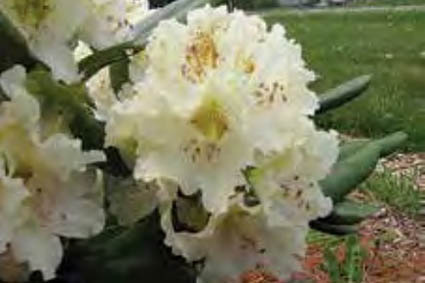 Holly’s Faith Elep., ‘Christina Dee’ (s) X ‘My Jane’, reg. 2015, hardy to -10°F (-23°C), named for his wife, Holly. Seed from T. Ahern. |
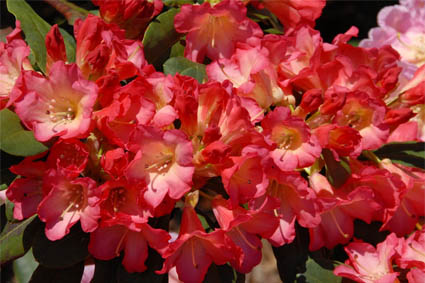 Inner Glow Elepidote, parentage unknown, reg. 2012. |
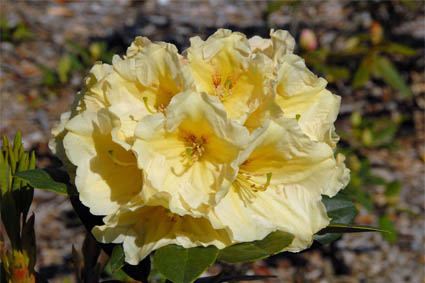 Joe’s Moon Glow Elepidote, ‘Capistrano’ (s) X ‘Early Light’, reg. 2012. |
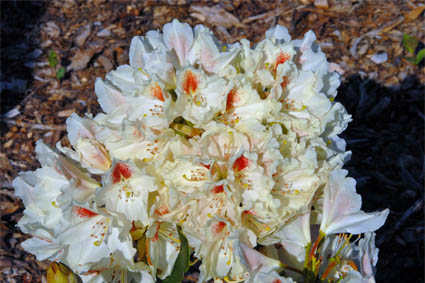 John’s Flare Elepidote, ‘Capistrano’ (s) X ‘Furnivall’s Daughter’, reg. 2011, named for John and the prominent flare. |
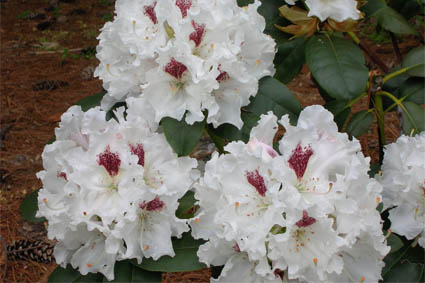 Jonathan Bryce Elepidote, ‘Blue Peter’ (s) X ‘White Dimples’, reg. 2005. |
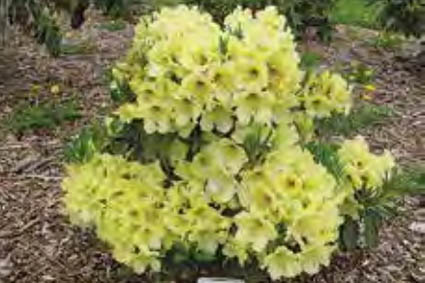 Lemon Lollipop Elepidote, ‘Austin’s Gold’ (s) X ‘Capistrano’, reg. 2013. |
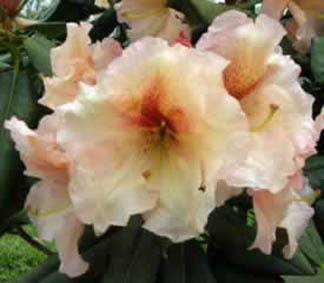 Morning Melody Elepidote, parentage unknown, reg. 2011, name coined to express the joy of seeing this plant in the morning. |
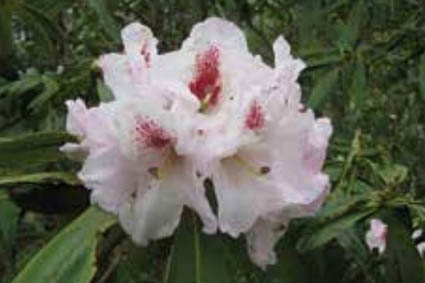 ‘Painted Bride’ Elepidote, ‘Mrs. T.H. Lowinsky’ (s) X calophytum, reg. 2013. |
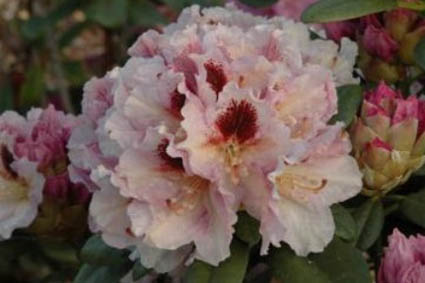 Philip Dee Elepidote, ‘Casanova’ (s) X ‘Peter Alan’, reg. 2005. |
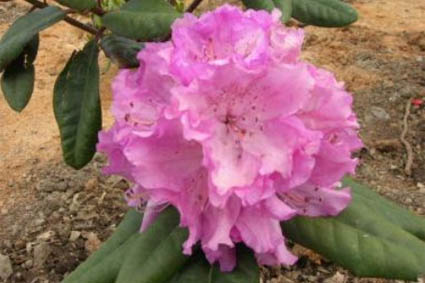 Pink Charm Elepidote, unknown parentage, not registered, Zone 5, Large frilly pink flowers. |
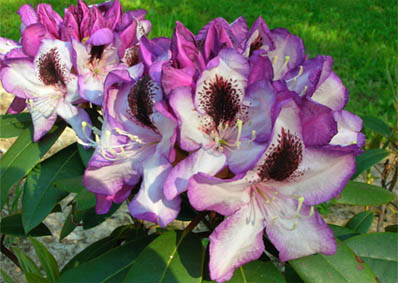 Ruth’s Showstopper Elepidote, ‘Tolstead’s Ma Belle’ (s) X ‘Virginia Delp’, reg. 2006, John's hybrid, but named by N.K. King. |
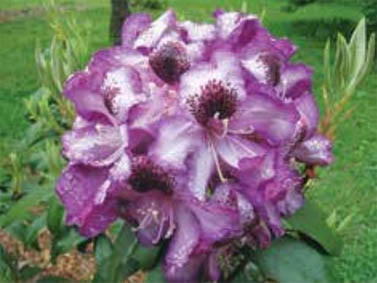 Ruth’s Sister Elepidote, ‘Tolstead’s Ma Belle’ (s) X ‘Virginia Delp’, reg. 2013, sister seedling of ‘Ruth’s Showstopper’. |
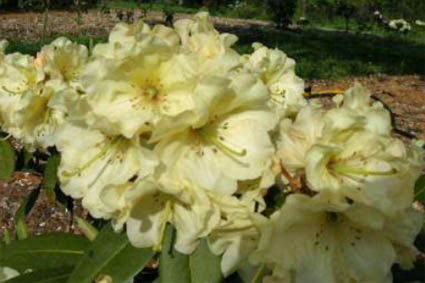 Silvia Dee Elepidote, unknown cross, not registered, Zone 7, Large cream colored flowers with a bright yellow center. |
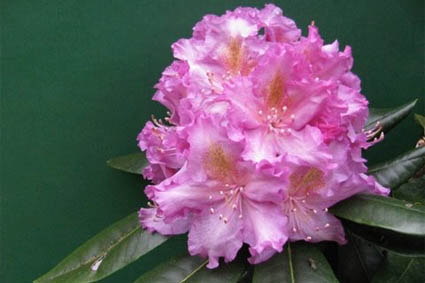 Silvia Marie Elepidote, ‘Janet Blair’ (s) X ‘Purple Lace’, reg. 2011, named for the John’s daughter-in-law. |
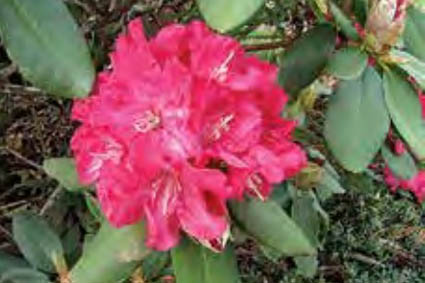 Spring Flare Elepidote, ‘Scintillation’ (s) X ‘Firestorm’, reg. 2015, hardy to -10°F (-23°C). |
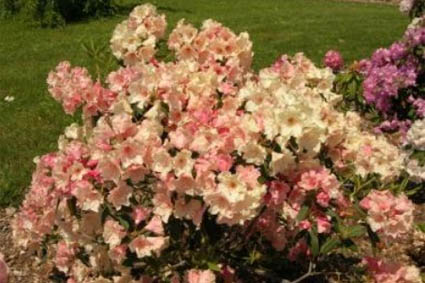 Strawberry Vanilla Elepidote, unknown cross, not registered, Zone 5, pink And white flowers cover this plant every year. |
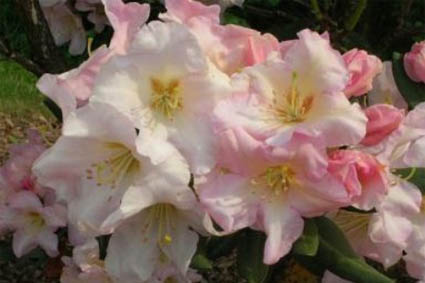 Swatara Elepidote, parentage unknown, not registered, Hardy in zone 6. Raised by John Doppel. |
No picture was available for the following:
|
Charming Pink
Elepidote, ‘Pink Flourish’ (s) X ‘Cape White’, reg. 2012, with 5 very wavy-edged lobes, deep pink in bud, opening inside purplish pink at margins, blending into pale purplish pink towards the center, with a light yellow dorsal blotch, outside purplish pink, with pale purplish pink midribs. |
|
Dave’s Delight
Elepidote, ‘Newburyport Belle’ (s) X ‘Olin O. Dobbs’, reg. 2005, with 5 flat-edged lobes, reddish purple in bud, inside light purple, edged with a broad band of reddish purple, with a dark red basal blotch and numerous spots of the same color extending upwards on the dorsal and two adjacent lobes; outside purplish pink. Named for John's son-in-law. |
|
Early Light
Elepidote, ‘Vinecrest’ (s) X ‘Janet Blair’ X ( ‘Donna Hardgrove’ X ‘Weston’s Hardy Yellow’), not registered, 7 slightly wavy-edged lobes, light red in bud, opening light yellow; slightly scented. Pollen fertile but usually seed sterile. John got the seed from A. Glassman. |
|
Jawndice
Elepidote, [(‘Flash Dance’ x unknown), selfed], not registered, John didn't like the plant habit, but used Jawndice extensively when hybridizing for yellow. |
|
John’s Lavender Haze
Elepidote, ‘Minnetonka’ (s) X ‘Smokey’, reg. 2012, 5 wavy-edged lobes, purplish red in bud, opening inside light purple, with a pale yellow-green blotch on the dorsal lobe; outside light reddish purple. |
|
Lavender Haze
Elepidote, ‘Minnetonka’ (s) X ‘Smokey’, reg. 2012, 5 wavy-edged lobes, purplish red in bud, opening inside light purple, with a pale yellow-green blotch on the dorsal lobe; outside light reddish purple. |
|
Lil’ Darlin
Elepidote, ‘Capistrano’ (s) X ‘September Song’, reg. 2012, 6 flat-edged lobes, red in bud, opening inside light orange-yellow, with greenish yellow speckles on the dorsal lobe; outside deep yellowish pink, changing to light yellowish pink at the base. |
|
Misty Memory
Elepidote, ‘Casanova’ (s) X ‘Goldsworth Orange’, reg. 2012, 5 flat-edged lobes, deep pink in bud, opening inside pale purplish pink, fading to pale yellow-green, with red dorsal spotting, which fades to light yellow; outside purplish pink and pale purplish pink; not scented. |
|
Paul Dee
Elepidote, ‘Calsap’ (s) X Janet Blair’, reg. 2011, 5 wavy-edged lobes, deep purplish pink in bud, opening inside white & shading to light purple at margins, with a prominent, elongated, dark red, spotted dorsal blotch, outside light purple. Named for John's son. |
|
Pink Pirouette
Elepidote, ‘Pink Flourish’ (s) X ‘Princess Mary of Cambridge’, reg. 2012. 5 wavy-edged lobes, purplish red in bud, opening inside purplish pink, with a light yellowish brown dorsal blotch; the central area on each lobe purplish pink, giving a star-like appearance; outside deep purplish pink. |
|
Purple Cape
Elepidote, ‘Sefton’, open pollinated (s), reg. 2012, 5 flat-edged lobes, reddish purple in bud, opening inside purple, with reddish orange dorsal spotting, outside purple, with vivid reddish purple midribs. |
|
Spring Sprite
Elepidote, ‘Capistrano’ (s) X ‘September Song’, reg. 2012, 5 wavy-edged lobes, red in bud, opening inside light yellow at center, shading outward to light yellow, edged with yellowish pink, and with a red, speckled dorsal blotch; outside yellowish pink, shading to yellowish pink at edges. |
|
White Marsh
Elepidote, parentage unknown, reg. 2012, 5 wavy-edged lobes, purplish red in bud, opening inside pale purplish pink, shading to white; lightly spotted purplish red, changing to orange-yellow on the lower half of the dorsal lobe; outside deep purplish pink; not scented. |
Part 4: John Doppel Legacy Collection
from the Jenkins Arboretum Fall 2016 Newsletter
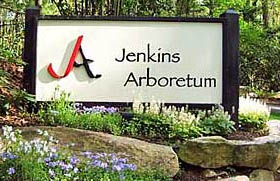 Jenkins Arboretum & Gardens is a member of the Plant Collections Network of the American Public Garden Association (formerly North American Plant Collections Consortium) whose goal is to ensure the preservation of plant germplasm. Jenkins displays one of the most comprehensive collections of azaleas and rhododendrons in the country. What is remarkable is what they are doing to expand and maintain this remarkable collection. As they focus on the best new hybrids from local, East Coast hybridizers, there are occasionally opportunities to add entire collections of special plants. Last summer, they were presented with a rare and very generous offer to do just that.
Jenkins Arboretum & Gardens is a member of the Plant Collections Network of the American Public Garden Association (formerly North American Plant Collections Consortium) whose goal is to ensure the preservation of plant germplasm. Jenkins displays one of the most comprehensive collections of azaleas and rhododendrons in the country. What is remarkable is what they are doing to expand and maintain this remarkable collection. As they focus on the best new hybrids from local, East Coast hybridizers, there are occasionally opportunities to add entire collections of special plants. Last summer, they were presented with a rare and very generous offer to do just that.
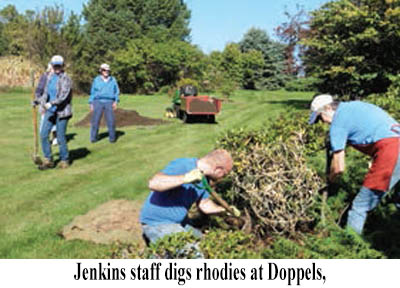 John Doppel, the prolific and well-known rhododendron hybridizer and his wife, Holly, decided it was time to begin planning for their move from their 10-acre Berks County property to something a bit more manageable. This is the property where John had been growing his hybrids for many years and his gardens were bursting at the seams. Many of these hybrids had been registered through the Royal Horticultural Society (the organization through which all rhododendrons are registered) and the Doppels wanted to ensure that these plants would be preserved for all to enjoy. Instead of leaving this collection to chance in the hands of the future owner, John and Holly offered them to the Arboretum.
John Doppel, the prolific and well-known rhododendron hybridizer and his wife, Holly, decided it was time to begin planning for their move from their 10-acre Berks County property to something a bit more manageable. This is the property where John had been growing his hybrids for many years and his gardens were bursting at the seams. Many of these hybrids had been registered through the Royal Horticultural Society (the organization through which all rhododendrons are registered) and the Doppels wanted to ensure that these plants would be preserved for all to enjoy. Instead of leaving this collection to chance in the hands of the future owner, John and Holly offered them to the Arboretum.
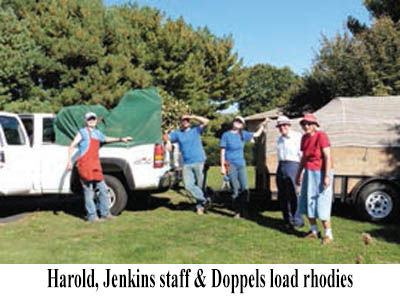 In October 2015, the Jenkins Arboretum's horticulture staff visited the Doppel garden with shovels and burlap in hand to dig, and dig, and dig some more. They filled a trailer to the brim and the back of the Arboretum's pickup truck was overflowing. In total, nearly 50 of John's hybrids had been rescued, 35 of which were named and registered. This exceptional collection is the culmination of nearly three decades of hybridizing and field trials. Within three days, all of these plants found new homes at the Arboretum. The majority reside on Elisabeth's Walk. If you visit the collection, you won't be able to miss them as their original, full-sun growing conditions made for short, compact, very full plants that, for now, look a bit out of place in our woodland garden. This growing condition, however, also created a heavy bud set and the promise of a spectacular flower display in the spring. To thank the Doppels, and to celebrate this new collection in bloom, the Arboretum arranged for a special viewing party in June of 2016 and the plants did not disappoint. Though their initial bloom was undoubtedly their best, we're sure these plants will keep people coming back year after year.
In October 2015, the Jenkins Arboretum's horticulture staff visited the Doppel garden with shovels and burlap in hand to dig, and dig, and dig some more. They filled a trailer to the brim and the back of the Arboretum's pickup truck was overflowing. In total, nearly 50 of John's hybrids had been rescued, 35 of which were named and registered. This exceptional collection is the culmination of nearly three decades of hybridizing and field trials. Within three days, all of these plants found new homes at the Arboretum. The majority reside on Elisabeth's Walk. If you visit the collection, you won't be able to miss them as their original, full-sun growing conditions made for short, compact, very full plants that, for now, look a bit out of place in our woodland garden. This growing condition, however, also created a heavy bud set and the promise of a spectacular flower display in the spring. To thank the Doppels, and to celebrate this new collection in bloom, the Arboretum arranged for a special viewing party in June of 2016 and the plants did not disappoint. Though their initial bloom was undoubtedly their best, we're sure these plants will keep people coming back year after year.
Click Here for printable PDF of this page.